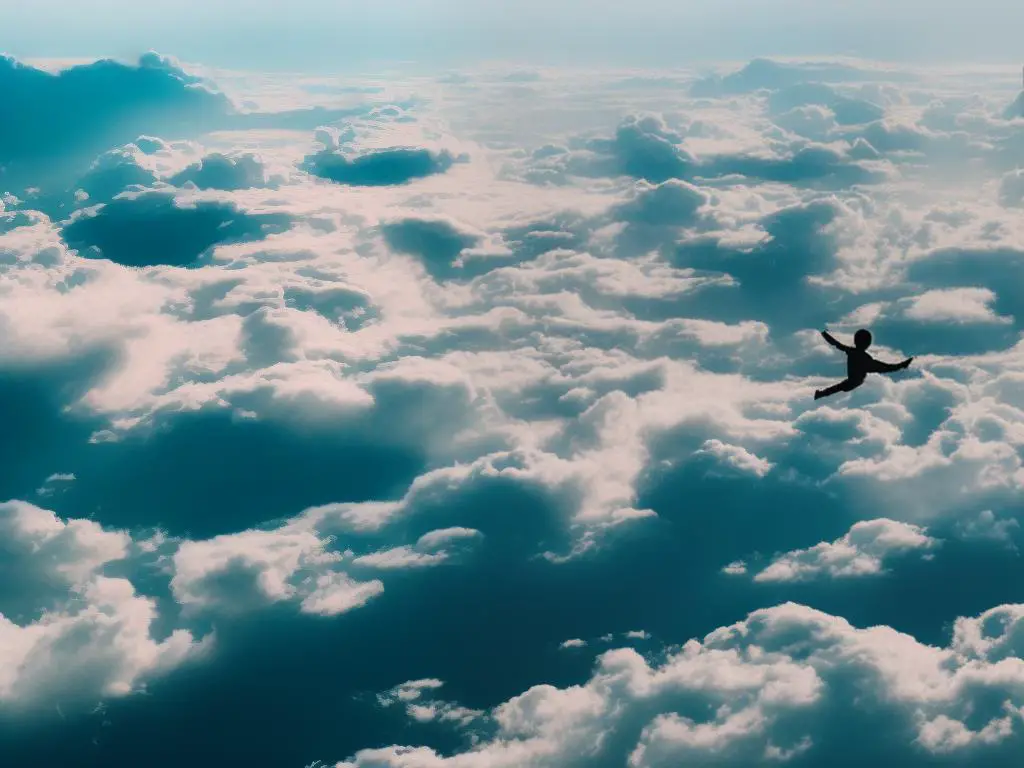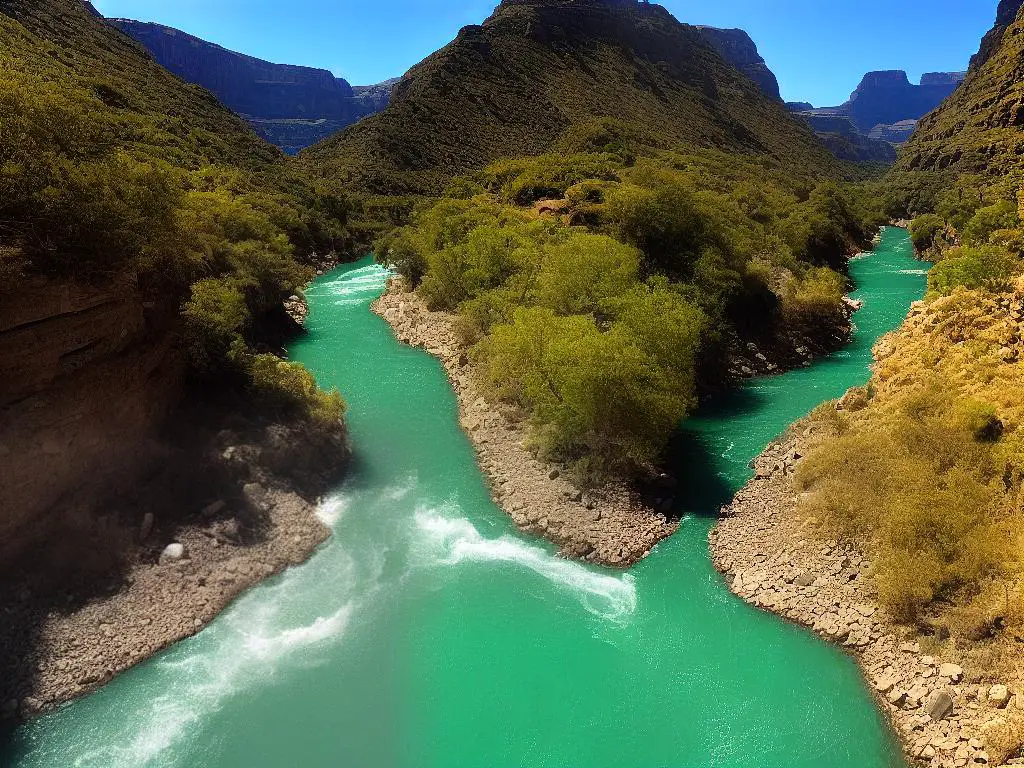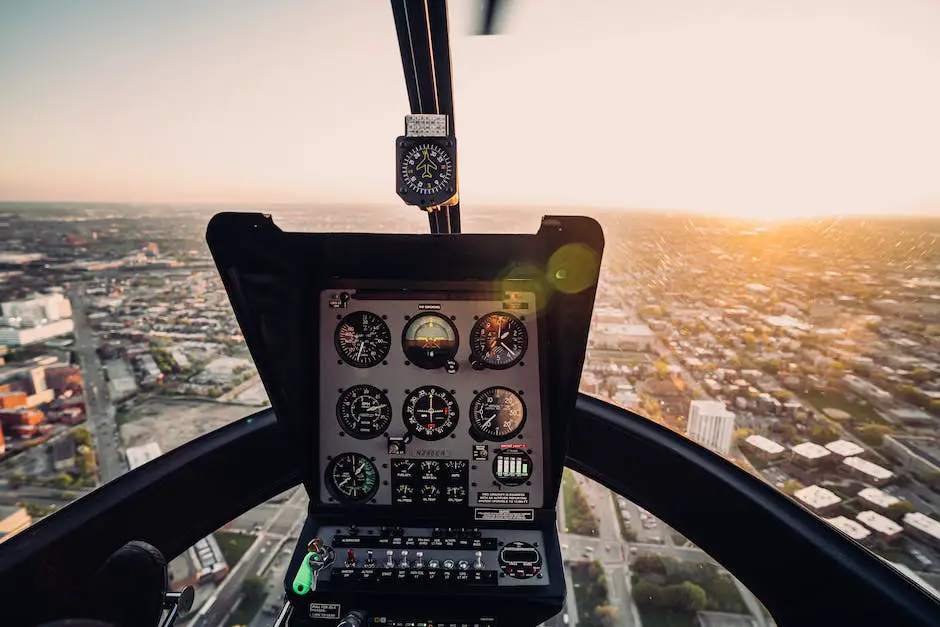Imagine soaring above the Earth, gliding effortlessly through the sky, and looking down upon a breathtaking canyon landscape – this captivating scene is an unforgettable experience that many people yearn for, whether in reality or in dreams. This essay explores the fascinating history and cultural significance of flying dreams, the geological wonders of canyons, thrilling real-life flying adventures, and the future of virtual reality in offering immersive, lifelike flying experiences.
History of Flying Dreams
Ancient Civilizations and Flying Dreams
Flying dreams have a long and rich history, dating back to ancient civilizations. In many ancient cultures, dreams of flying were seen as a representation of freedom, spiritual growth, and a connection to the divine. The ability to fly symbolized a higher state of consciousness or an ascension to a higher realm. For example, ancient Egyptians believed that flying dreams were messages from the gods, with the dreamer receiving divine guidance, wisdom, or a prophecy.
Greek mythology also has numerous examples of flying dreams and their implications. The famous myth of Icarus, the young man who flew too close to the sun with wax wings, is this culture’s cautionary tale of aspiring beyond one’s human limitations. However, it also signifies the innate human desire for transcendence and freedom.
Shamanic cultures, like those of indigenous Americans, hold flying dreams in high regard. In these cultures, the dreamer was believed to have a magical or transcendent capability through the experience of flying. For these societies, the dreamer could possibly become a spiritual healer or leader, interpreting the messages they received from the dream world and applying them to their community.
Flying Dreams and Religion
In many religious traditions, flying dreams have been viewed as a sign of divine intervention or union with a higher power. For instance, in Christianity, biblical figures such as angels and cherubs are often depicted with wings, symbolizing their connection to the heavenly realm. Dreams of flying can be interpreted as a connection to one’s spiritual nature or the divine within.
Islam also considers flying an essential element of spiritual growth. According to Islamic literature, the Prophet Muhammad experienced a night journey on a mythical creature called Buraq, where he ascended through the heavens and met with previous prophets. Flying dreams in this context could indicate progress on one’s spiritual path or a communion with higher knowledge.
Hinduism and Buddhism also attribute tremendous significance to flying dreams. In Hindu mythology, various gods have the ability to fly and are often associated with wisdom, virtue, and spiritual growth. Similarly, in Buddhist teachings, achieving higher states of consciousness or enlightenment can be symbolized by the experience of flying or levitating in dreams.
Dream Interpretation and Psychology
In modern psychology, the interpretation of flying dreams is linked to personal growth and self-development. Sigmund Freud, the father of psychoanalysis, believed that flying dreams represented sexual energy and a desire for freedom. On the other hand, Carl Jung, another influential psychologist, thought flying dreams were more about the dreamer’s search for self-discovery and the desire to break free from limitations.
Dreaming of flying over a canyon, in particular, can have multiple symbolic meanings. On one hand, it could signify surmounting challenges and overcoming obstacles. The soaring sensation might also represent personal freedom, growth, and the courage to traverse uncharted territory. The image of the canyon itself could be seen as a representation of life’s complexities and the powerful forces of nature that shape our existence.
Introduction
Dreams of flying have captured the human imagination for centuries, evoking feelings of freedom, spiritual growth, and personal development. Throughout history, these dreams have been imbued with cultural and historical significance, whether viewed as messages from gods, higher states of consciousness, or psychological symbols. Soaring dreamscapes, like flying over a canyon, can hold even greater meaning and sensations of exhilaration. As we explore the world of dreams and their interpretations, we aim to understand the allure and symbolism of dreams of flying over a canyon.

Psychology of Flying Dreams
Psychology of Flying Dreams: Symbolism and Theories
Within the field of dream analysis, flying dreams often represent ambitions, personal growth, and a sense of liberation from life’s limitations. This experience of release is heightened when one dreams of flying over a canyon, as the vast and breathtaking scenery can further emphasize these emotions. To unpack the deeper meaning and symbolism of such dreams, we will examine various theories and perspectives from psychologists and dream analysts, shedding light on this fascinating aspect of the human mind.
Freudian Perspectives on Flying Dreams
Freudian analysts might interpret flying dreams as expressions of repressed desires or impulses, with the sensation of flying symbolizing liberation from societal constraints or norms. In a dream of flying over a canyon, the canyon could be seen as a representation of a psychological obstacle that the dreamer is overcoming or hoping to overcome. This fits well with the idea of personal growth, as the dreamer in this scenario is literally rising above their personal limitations or fears.
Jungian Perspectives on Flying Dreams
Carl Jung, the founder of analytical psychology, believed that dreams are a window into the collective unconscious – a reservoir of shared human experiences, archetypes, and symbols. From a Jungian perspective, flying dreams can be seen as manifestations of the archetype of ascension. This archetype is often associated with self-realization, spiritual growth, and the pursuit of wisdom or enlightenment. In the context of dreaming about flying over a canyon, the dreamer might be exploring their potential for personal development and transcendence.
Personal Growth and Transformation
Dreams of flying over a canyon may also represent a transformative process that the dreamer is undergoing or striving for in their waking life. The act of flying can symbolize shedding old patterns, thoughts, or beliefs that may be holding the dreamer back. The canyon, therefore, might represent the old or outdated modes of thinking, which the dreamer is seeking to rise above in order to grow or evolve.
Flying Dreams and Creative Ambition
Another interpretation of flying dreams is that they are associated with creative ambition and imagination. The ability to fly in dreams is often linked with artistic or intellectual flights of fancy, pushing the boundaries of conventional thought, and breaking free from limitations. In a dream of flying over a canyon, the dreamer’s ambition and creativity might be soaring above the perceived boundaries and exploring new possibilities.
The Canyon: A Symbol of Opportunities and Challenges
The canyon is an important aspect of the flying dream, as it not only adds depth and dimension to the dream, but also serves as a symbol of challenges or obstacles faced by the dreamer. Flying over a canyon might reveal the dreamer’s determination to take on new challenges and conquer unforeseen obstacles that lie ahead in their personal journey. This can be seen as an indicator of personal strength, resilience, and the ability to face uncertainties with courage.
Dreaming of Flying Over a Canyon
Experiencing the dream of flying over a canyon is a complex phenomenon that carries various implications from the realms of psychology and dream analysis. Different theories interpret this dream as a symbol of personal growth and liberation, while others emphasize its spiritual or imaginative aspects. Furthermore, the presence of the canyon introduces an element of surmounting obstacles and facing new trials as the dreamer soars above them. Regardless of the perspective one adopts, it is clear that such dreams carry significant importance for the individual, unveiling their internal ambitions, strengths, and yearnings for transformation.

The Canyons: Geological Wonders
Connecting with Canyons: Exploring Earth’s Natural Wonders Through Dreams
Dreaming of flying over a canyon may also be tied to our fascination with these geological wonders. The mesmerizing beauty and unique formations found in canyons have captivated humans for centuries. Often sculpted by the gradual erosion of water, these deep ravines etched into landscapes provide a remarkable opportunity to witness the splendor of nature. It’s intriguing to consider that your unconscious mind might be connecting with some of the world’s most famous canyons, such as the Grand Canyon or the Colca Canyon, and choosing to explore them through your dreams. Let’s take a brief journey into the exhilarating adventures these canyons offer for tourists and adrenaline seekers alike.
Grand Canyon: Mysterious Megafissure
As one of the seven natural wonders of the world, the Grand Canyon has long been renowned for its sheer size and spectacular colorful layers of rock. Spanning an impressive 277 miles in length, 18 miles in width, and one mile deep, it’s no wonder that every year millions of people flock to Arizona to witness the power of the Colorado River and its intricate carvings in the landscape. The activities surrounding the Grand Canyon are seemingly endless. Curious minds can explore its ancient history at visitor centers, while outdoor enthusiasts can hike, river raft, or even take to the sky in a helicopter tour for an unparalleled aerial view.
Fish River Canyon: Africa’s Great Ravine
When it comes to African canyons, the Fish River Canyon in Namibia holds the title as the continent’s largest. Stretching over 100 miles in length and reaching depths of over 1,800 feet, the Fish River’s dramatic winding path showcases immense geological splendor with its surrounding cliffs and gorges that have been slowly eroding for more than 500 million years. Adventure seekers and avid hikers can traverse the canyon on a challenging 54-mile trek lasting up to five days and witness its spectacular beauty firsthand.
Antelope Canyon: A Labyrinth of Light
Located in the American Southwest in Arizona, Antelope Canyon is a geological marvel that has captivated the hearts of photographers and travelers alike. Floodwaters and wind have sculpted the beautiful and colorful sandstone into an ethereal landscape of undulating, fluid shapes. The narrow, twisting walls create dramatic light shafts that fill the canyon with a magical glow. Tours of this exquisite slot canyon are offered year-round with both general and photography-focused options available.
Colca Canyon: Andean Home of the Condor
Peru’s Colca Canyon captivates tourists with its jaw-dropping scale and rugged beauty. Found in the Andean Mountain range, it’s twice as deep as the Grand Canyon and has been steadily shaped by the volcanic activity of the region. The canyon attracts birdwatchers eager to spot the majestic Andean condor soaring high above the cliffs and thermal updrafts. Tourists can also explore the traditional villages and ancient terraced agricultural sites that fill this deep valley.
Great Canyons Worldwide: Masterpieces of Nature
Our planet is home to vast and incredible landscapes, such as the expansive Grand Canyon and the intricately twisting Antelope Canyon. These geological masterpieces provide a unique insight into the power and fragility of nature, as well as the processes that have shaped our world over millions of years. Tourists and adventure seekers looking to revel in the beauty of these natural wonders have numerous options, ranging from hiking and river rafting to canyoneering and birdwatching. As you dream of flying over a canyon, consider the majesty and wonder of these majestic landscapes to inspire your next adventure.

Adventures in the Sky: Real-life Flying Over Canyons
Hang Gliding Over Canyons: The Ultimate Adventure
Envision an adventure like no other, soaring high above beautiful canyons, picturesque landscapes stretching out beneath you: welcome to the world of hang gliding. Your body is positioned parallel to the ground as you experience the cool breeze, all while taking in the awe-inspiring sights of our planet’s geological wonders from a bird’s-eye perspective. Hang gliding offers adventurers an unparalleled way to view the stunning beauty of these canyons, providing a unique and memorable experience. To enjoy this thrill while staying safe, it is vital to undergo proper training and follow all necessary precautions before embarking on this daring escapade.
Paragliding Over Canyons
Another popular aerial adventure that appeals to those seeking the thrill of flying over canyons is paragliding. Unlike hang gliding, where pilots lie flat while navigating the glider, paragliding positions pilots in a seated harness, providing a more stable and comfortable flight. Floating gracefully above the canyons, paragliders can enjoy a more tranquil form of flight while marveling at the vast expanse below. Though it may seem relatively safer than hang gliding, it is essential not to underestimate the potential risks of paragliding. Individuals must receive proper training and always follow safety guidelines to ensure an enjoyable and secure experience.
Hot Air Ballooning Over Canyons
For those who prefer a more gentle ride over canyons, hot air ballooning is the perfect choice. It provides a serene, almost magical experience, as passengers float above the canyon floors and take in the magnificent sights from the comfort of a wicker basket. Hot air balloons rely on hot air’s buoyancy to lift, allowing for a slow and steady ascent into the sky. Although hot air ballooning is generally considered safe, unexpected weather changes or equipment failure can pose risks, reminding passengers to stay cautious and informed on proper safety measures.
Helicopter Tours Over Canyons
When seeking an adrenaline-pumping adventure over canyons without the need for physical exertion, helicopter tours are an excellent option. These guided aerial tours provide incredible, up-close views of the canyons that simply can’t be achieved from the ground. With an experienced pilot at the controls, passengers can sit back and enjoy the exhilarating ride through the narrow gaps and towering cliffs of the canyon. However, similar to the previously mentioned aerial activities, helicopter tours also carry potential risks often associated with mechanical failure or pilots’ errors. It is crucial to book a tour through a reputable company and maintain awareness of proper safety protocols at all times.
Flying Over Canyons: A Thrilling Dream and Its Challenges
For thrill-seekers and adventurers, the dream of flying over canyons offers a unique and unforgettable experience that combines excitement, adrenaline, and awe-inspiring natural beauty. However, as with any daring adventure, there are inherent risks involved in flying over canyons, such as sudden weather changes, equipment malfunctions, and human errors. As a result, it is crucial for individuals interested in pursuing this dream to undertake proper training and education in their chosen discipline, follow all safety guidelines, and stay updated on weather conditions. By prioritizing safety and preparedness, enthusiasts can indulge in the thrilling dream of flying over canyons while minimizing the potential risks.
The Future of Virtual Reality in Flying Experiences
Virtual Reality: Bringing the Dream of Flying Over Canyons to Life
In recent years, virtual reality (VR) technology has made significant strides in creating increasingly realistic and immersive experiences for users across various industries, including gaming, education, and healthcare. One area where VR has shown significant potential is in flying experiences, making the dream of flying over canyons more accessible to the general public. Through virtual reality, enthusiasts can now explore breathtaking landscapes and soar through the skies over awe-inspiring canyons, all from the comfort and safety of their own homes. This innovative technology provides an exciting alternative for those who want to experience the thrill of flying over canyons without the inherent risks associated with real-life aerial adventures.
Current State of Virtual Reality in Flying Experiences
As of today, there are several VR systems available that cater to flying enthusiasts, with a plethora of applications and digital content that transport users to various locations and situations. Many of these systems utilize high-definition graphics and intricate details in their visuals, along with 3D audio integration, to simulate an environment that seems genuinely as if the user is soaring over a canyon or any other landscape. Some VR systems even incorporate haptic feedback and motion controls, allowing users to interact with their surroundings and truly feel like they are flying.
In addition to consumer-focused VR systems, professional-grade systems have also been making an impact, particularly in the realm of pilot training. Simulator platforms used by pilots to practice flight maneuvers and respond to emergency situations have been adopting VR technology to create more accurate and lifelike representations of their real-world counterparts. This has not only become cost-effective but also improved the overall quality of pilot training, which translates to safer skies for everyone.
The Future of Virtual Reality in Flying Experiences
As we look ahead, the potential for VR in flying experiences seems immense. With technology constantly evolving and advancing, it is reasonable to expect that future VR systems will become even more sophisticated, providing users with an unrivaled flying experience.
Developments in fields like haptic feedback, motion tracking, and photorealistic graphics would only elevate the overall realism and immersion offered by VR experiences. Improved haptic feedback technology would enable users to feel even the subtlest nuances of flying, such as the wind or vibrations from their aircraft. Enhanced motion tracking technology would also allow for more accurate and responsive interactions between the user and their environment.
Emerging technologies, such as augmented reality (AR) and mixed reality (MR), could also potentially play a role in the future of flying experiences. By combining aspects of real-world environments with digital overlays, these technologies could create entirely new methods of exploration and interaction, further blurring the line between the virtual and real worlds.
Moreover, there is potential for VR technology to extend beyond personal and training purposes, with possible applications in tourism and entertainment. For example, virtual flying tours over famous landmarks and inaccessible landscapes could allow users to appreciate the beauty and scale of these locations without impacting the natural environment or facing travel restrictions. These types of experiences could become a popular offering from travel companies, museums, or even as part of guided tour packages, expanding the global reach of VR technology.
In conclusion, the future of virtual reality in flying experiences seems promising and full of possibilities. As technology continues to advance and become more sophisticated, users will have the chance to enjoy ever-more realistic and immersive experiences, transforming not only the way we view and interact with the world around us but also the ways in which we learn, explore and experience something even as exhilarating as flying over a canyon.

As we delve into the world of flying dreams and explore the beauty and excitement of flying over canyons, we unveil the human desire for freedom, personal growth, and adventure. Through technological advancements and innovative virtual reality experiences, we are now closer than ever to fulfilling our dreams of taking to the skies and experiencing the awe-inspiring landscapes our world has to offer. Embrace the magic of flight and the boundless opportunities it presents – for it is within our dreams and ambitions that we truly soar.

